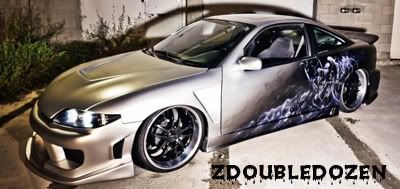So I have a 12" dual voice coil sub and a 4 channel amp. I have it set to two channel and have the channels bridged to power the sub. I recently replaced all the undersized wire with high quality 10 gauge, and was wondering what wiring the voice coils in series or parallel will do, particularly to output level.

We kinda need more info.
Like voice coil impedence and amp impedence.
Better yet, give us the make and model of the sub and the amp.

"In Oldskool we trust"
It's a Polk Audio DXi 12" DVC, 360W RMS, 4-ohm impedance. The amp is a Craig Powerplay 500, I can't find any specs on it because it's so old. It's a model ma4500, advertises 2-ohm stable.

If the amp is 2 ohm and you want to run it at 2 you just need to wire your sub parallel (all +'s and-'s together)
This is also one of the first things mentioned in the audio faq above if you would like to read it.
Have a nice day.
I'm willing to bet it's 2ohm stereo stable on each block. Meaning you should probably bridge each block with a single voice coil. So one coil to bridged channel 1&2 and the other coil to bridged channel 3&4. I feel like that's safer than bridging the whole thing down to two ohms since we aren't 100% sure it can do that.

"In Oldskool we trust"
Jordan wrote:If the amp is 2 ohm and you want to run it at 2 you just need to wire your sub parallel (all +'s and-'s together)
This is also one of the first things mentioned in the audio faq above if you would like to read it.
But, he has 4 voice coils, I assume all at 4 ohms each, parrallel would be 4 ohms / 4 coils = 1 ohm. You want a combo. Wire the voice coils in parrallel, 4ohms/2 coils = 2 ohms then wire the speakers in series to the amp which would give you 4 ohms impedance i think. Not really sure how you would go two ohms right now, just woke up and not really thinking all that clear yet.
- Your not-so-local, untrained, uncertified, backyard mechanic. But my @!#$ runs
Never mind, only 1 voice coil, parallel it man, 4 ohms / 2 coils is 2 ohms.
- Your not-so-local, untrained, uncertified, backyard mechanic. But my @!#$ runs
Use the below 2 links to help you with what you should run.
Also a properly tuned Box (hz) for the sub out weigh's impedance in performance and quality.
http://www.the12volt.com/ohm/ohmslawcalculators.asp
http://www.the12volt.com/ohm/ohmslaw.asp

Thanks for all the help guys. I wired it parallel and if I turn the volume up too high the amp cuts out, but it sounds good all the way up until that point. I'm guessing that means it's too much for the amp. Should I wire it in series? Or should I bridge each pair of coils to a pair of channels?

Definitely means you're overloading it. Probably thermal protection. Yes, I would bridge 2 channels for each coil.

"In Oldskool we trust"
Y3llowCav wrote:Definitely means you're overloading it. Probably thermal protection. Yes, I would bridge 2 channels for each coil.
Am I able to merge the positive channels together and split them again if I do this? I'd like to connect both of them at the sub box's terminals and split them again inside the box to run each coil if I can for simplicity.

No, DO NOT do that. You'll need separate wires for each coil.

"In Oldskool we trust"
Alright. This should give it 4-ohms per channel pair, thus 2-ohms per channel instead of 2-ohms on a pair, yes?

You're going to bridge each block(channels pair) with a 4 ohm load. Both blocks have their own circuitry/power supply, etc. So they are both independent 4 ohm loads. Just make sure that you have both blocks set exactly the same with gain/bass boost/ frequency, etc. Most have a switch that will allow you to slave the other block and render its adjustments from the master block. But since your amp is so old I can't find any data on it and don't know for sure.

"In Oldskool we trust"
All it has is a 2/3/4 channel selector, a gain screw for each pair of channels, and a 80Hz/150Hz/Full low pass switch per channel, which I run on full because I have my deck's low pass set at 120Hz. I don't run any bass boost.













